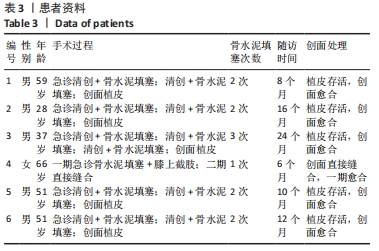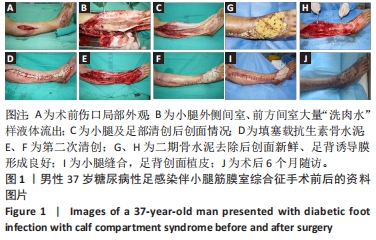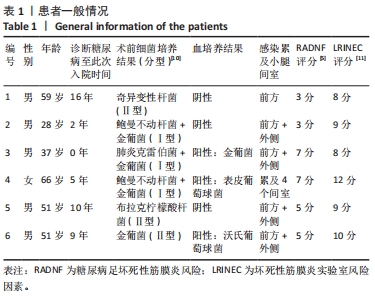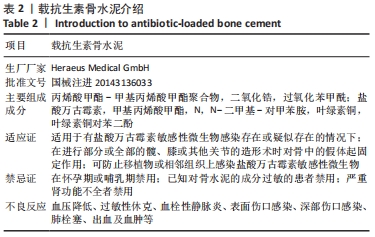中国组织工程研究 ›› 2024, Vol. 28 ›› Issue (17): 2637-2641.doi: 10.12307/2024.441
• 组织工程骨材料 tissue-engineered bone • 上一篇 下一篇
载抗生素骨水泥治疗糖尿病足坏死性筋膜炎致小腿筋膜室综合征
徐 鹏,薛明宇,芮永军,卜凡玉,郭晓峰,谢艺恺
- 苏州大学附属无锡九院,江苏省无锡市 214000
Antibiotic-loaded bone cement in treatment of calf compartment syndrome caused by diabetic foot necrotizing fasciitis
Xu Peng, Xue Mingyu, Rui Yongjun, Bu Fanyu, Guo Xiaofeng, Xie Yikai
- Wuxi 9th Affiliated Hospital of Soochow University, Wuxi 214000, Jiangsu Province, China
摘要:
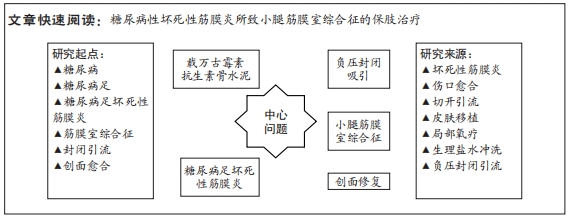
文题释义:
坏死性筋膜炎:是一种累及皮肤及皮下筋膜的感染性疾病,该病发展迅猛,早期漏诊率达85%-100%,发病率不高,但截肢率达70.5%、病死率高达约20%。与筋膜室综合征不同,坏死性筋膜炎是深筋膜以浅的广泛软组织感染,一般不累及深部肌肉。小腿筋膜室综合征:指在一密闭间室内,由于压力升高影响血液循环而造成的间室内肌肉、神经等组织不可逆损害,常见病因包括挤压伤、缺血或感染后组织肿胀等原因使筋膜室内容物组织体积迅速增大,当小腿间室压力大于7.35 kPa时供应肌肉的小动脉关闭,形成缺血-水肿-缺血的恶性循环。筋膜室综合征一经确诊,应立即切开筋膜减压。
背景:目前坏死性筋膜炎的治疗方法大多是充分彻底清创后使用负压封闭吸引,该方法需要反复多次清创才能彻底清除坏死感染组织,给患者造成严重的身体负担和经济负担。
目的:介绍一种临床少见的病例——糖尿病足坏死性筋膜炎导致的小腿筋膜室综合征,总结使用载抗生素骨水泥进行治疗与综合管理的临床经验。方法:选择2017年8月至2020年8月苏州大学附属无锡九院收治的糖尿病性坏死性筋膜炎导致的小腿筋膜室综合征患者6例,男5例,女1例,平均年龄54岁,围术期整体把控患者全身情况并进行全身营养支撑治疗,所有患者均一期行彻底清创+载抗生素骨水泥填塞+负压封闭引流以控制感染、二期取出骨水泥并行创面修复治疗。出院后随访时观察患者创面愈合情况及有无红肿渗液发生。
结果与结论:①4例患者经过2次载抗生素骨水泥填塞后创面新鲜,诱导膜形成良好,1例经过3次抗生素骨水泥填塞后诱导膜形成良好,这5例患者二期经过植皮手术后创面均愈合良好;1例患者急诊手术时因术中血压难以维持且小腿4个间室均出现感染,急诊行膝上截肢,同时残端创面放置载抗生素骨水泥,二期骨水泥取出后创面直接闭合,创面一期愈合;②6例患者出院后随访6-24个月,末次随访时,6例患者创面均愈合良好、无红肿渗液等症状,患者生活质量明显改善,均对疗效表示满意;③对于临床高度怀疑糖尿病足坏死性筋膜炎时应警惕小腿筋膜室综合征的发生,早期诊断、及时切开减压至关重要,应用载抗生素骨水泥治疗糖尿病性坏死性筋膜炎导致的小腿筋膜室综合征短期疗效较好。
https://orcid.org/0000-0002-5163-1529(徐鹏)
中国组织工程研究杂志出版内容重点:生物材料;骨生物材料;口腔生物材料;纳米材料;缓释材料;材料相容性;组织工程
中图分类号:
